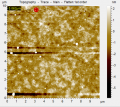Sunday, June 9, 2019
By:
They say time flies when you’re having fun. Even at this early point of the summer, I’m afraid that if I blink, I’ll miss the rest of it—week two felt, if anything, faster than the first. Maybe it’s because this week I got to start working at NIST on my research project. Or perhaps because there was so much going on each day. But mostly I think it’s because nothing makes a person so aware of the passage of time as the realization that it is limited. Still, nostalgia and goodbyes belong to blog post number ten[2]; I’d rather focus on the new people I met.
For example, I got to meet my research advisor at NIST: Joseph (Joe) Kopanski[b], a physicist who specializes in measuring and imaging the truly tiny. I got to work with him in the lab on the Atomic Force Microscope (AFM) which he uses to examine devices such as silicon chips at minute scales. The AFM works essentially by “feeling” a surface: a very sensitive probe reacts to the tiny forces generated as it is dragged across a surface. By applying electrical signals to the probe or the sample, additional forces dependent on the material properties of the sample can be resolved at the nanoscale. All of this means that scanning probe microscopy is a very powerful tool—if it can be calibrated correctly. And that’s part of my job this summer: using experimental techniques and computational modeling to examine the precise response of different AFM probes to a special test sample developed and fabricated at NIST. The data has the potential to refine existing models and make better quantitative measurements, and defect detection, of things like the silicon chips in your computer.
In the photo gallery is the first AFM image I have ever taken. The image represents a topographical map of an area only ten microns square. If you’re reading this on a computer screen, one pixel of the display would comfortably fit one hundred actual-size AFM images. An average cell of your body would fill the entire field of view of the microscope. The point is, this stuff is tiny. I’m excited to continue experimenting with this advanced piece of equipment, and I’m especially interested in using computational modeling to build a 3D, working model of the electronic system under study. That said, I’ve got a lot of work to do in the next eight weeks. Yet another reason to feel time flying by!
As cool as microscopy is, the most important thing this week from work was another introduction. What I didn’t expect is that the man I met would sit down and talk with me for over an hour. Dr. John Kasianowicz was his name, and he works with one of the scientists in my lab (hence his presence there on that day). He was the first one to write a paper about the potential of nanopores to allow the rapid sequencing of DNA. In the intervening two decades, that technology has indeed expanded to be one of the most important and versatile metrological tools in the study of DNA and other biopolymers. But our conversation didn’t focus on his work—he made sure it focused on my career. He gave sound advice, and expressed interest in my future as a scientist. In other words, he fulfilled the role of a mentor within the first minutes of our acquaintance. So despite all of the advice he gave me, perhaps the greatest takeaway from that conversation was his example: take time to be a mentor.
It seems I’ve already filled a page of twelve-point text, and I haven’t even had a chance to tell about all the fun things we did as a group this week. To fully describe them would easily take another page, and I’m sure the other blogs can give you a better idea of the cool stuff we did. But I’d be happy to give a breathless, run-on sentence full of some phrases that you won’t have any context for! Without further ado:
We had Taco Tuesday adventures, made Captain Cookie midnight runs, met Gus three times, put Eric in a tree, watched a Pride parade from the sixth story, stacked feet, saw planes, heard some jazz, got CPR trained on the street, bought some goat cheese (more on that next week), met the Father of the Internet, watched the Parent Trap, played with light (literally), played German, spoke German, learned about tea, did crosswords, watched baseball, respected the spectrum, survived without water for three days, and, most importantly, asked the question: Who but W. B. Mason?
I told you time was flying. Perhaps now you’ll understand why.
Here’s looking forward to another crazy, wonderful, wonder-filled week.
Joseph Tibbs



